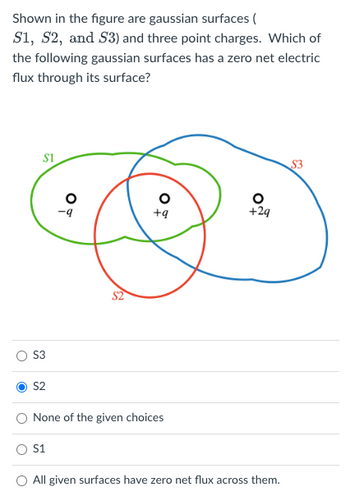
College Physics
11th Edition
ISBN: 9781305952300
Author: Raymond A. Serway, Chris Vuille
Publisher: Cengage Learning
expand_more
expand_more
format_list_bulleted
Concept explainers
Question
Shown in the figure are gaussian surfaces (S1, S2, and S3) and three point charges. Which of the following gaussian surfaces has a zero net electric flux through its surface?

Transcribed Image Text:Shown in the figure are gaussian surfaces (
S1, S2, and S3) and three point charges. Which of
the following gaussian surfaces has a zero net electric
flux through its surface?
S1
S3
S2
-9
S1
O
+9
None of the given choices
+2q
O All given surfaces have zero net flux across them.
$3
Expert Solution
This question has been solved!
Explore an expertly crafted, step-by-step solution for a thorough understanding of key concepts.
This is a popular solution
Trending nowThis is a popular solution!
Step by stepSolved in 3 steps with 3 images

Knowledge Booster
Learn more about
Need a deep-dive on the concept behind this application? Look no further. Learn more about this topic, physics and related others by exploring similar questions and additional content below.Similar questions
- A charge Q-7.14 nC is located at the center of a Gaussian sphere of radius R=10.0 cm. The sphere lies within a uniform upward electric field of magnitude E=2100 N/C. The net electric flux through the sphere is :arrow_forwardGaussian surfaces A and B enclose the same positive point charge. The area of surface A is two times larger than that of surface B. How does the total electric flux through the two surfaces compare?arrow_forwardAn infinite sheet of charge is located in the y-z plane at x = 0 and has uniform charge denisity o1 = 0.62 µC/m². Another infinite sheet of charge with uniform charge density o2 = -0.29 µC/m² is located at x = c = 33 cm.. An uncharged infinite conducting slab is placed halfway in between these sheets ( i.e., between x = 14.5 cm and x = 18.5 cm). d a/2 a/2| a/2 1) What is Ex(P), the x-component of the electric field at point P, located at (x,y) = (7.25 cm, 0)? N/C Submit 2) What is oa, the charge density on the surface of the conducting slab at x = 14.5 cm? | µC/m² Submit 3) What is V(R) - V(P), the potentital difference between point P and point R, located at (x,y) = (7.25 cm, -18.5 cm)? Submit 4) What is V(S) - V(P), the potentital difference between point P and point S, located at (x,y) = (25.75 cm, -18.5 cm)? V submit + 5) What is Ex(T), the x-component of the electric field at point T, located at (x,y) = (40.25 cm, -18.5 cт)? N/C Submit R.arrow_forward
- Two spherical, hollow conductors are concentrically nested as shown in the cross-sectional diagram below and electrically isolated from each other. A net charge of -3 nC is divided between the conductors, with a total of -12 nC on the inner conductor and +9 nC on the outer one. The charges are, of course, free to move between the surfaces within each shell but cannot move from one shell to the other. The inner conductor has an inner radius of a=2 cm, outer radius of b=3 cm. The outer conductor has an inner radius of c=6 cm, an outer radius of d=8 cm. a (a) In equilibrium, all of the excess charge is found on the surfaces. Why is there no charge between a and b, nor between c and d? (b) Determine the net charge on each surface (ie how much charge is there at r = a, at r = b, at r = c and at r= = d). (c) Is the charge on the outer surface equal to the net charge on the outer container, the net charge of the system, or some other amount? Explain briefly. (d) Find the surface charge…arrow_forwardA solid sphere of radius a is concentric with a hollow sphere of radius b, where b > a. If the solid sphere has a uniform charge distribution totaling +Q and the hollow sphere a charge of –Q, the electric field at radius r, where r < a, is which of the following, in terms of k = (4π∈0)–1? Choose the correct answer. kQ/b2 zero kQ/a2 kQr/a3 kQ/r2arrow_forwardGaussian surface 1 has twice the area of Gaussian surface 2. Both surfaces enclose the same charge Q. Is the electric flux through surface 1 greater than, less than, or the same as the electric flux through surface 2?arrow_forward
arrow_back_ios
arrow_forward_ios
Recommended textbooks for you
 College PhysicsPhysicsISBN:9781305952300Author:Raymond A. Serway, Chris VuillePublisher:Cengage Learning
College PhysicsPhysicsISBN:9781305952300Author:Raymond A. Serway, Chris VuillePublisher:Cengage Learning University Physics (14th Edition)PhysicsISBN:9780133969290Author:Hugh D. Young, Roger A. FreedmanPublisher:PEARSON
University Physics (14th Edition)PhysicsISBN:9780133969290Author:Hugh D. Young, Roger A. FreedmanPublisher:PEARSON Introduction To Quantum MechanicsPhysicsISBN:9781107189638Author:Griffiths, David J., Schroeter, Darrell F.Publisher:Cambridge University Press
Introduction To Quantum MechanicsPhysicsISBN:9781107189638Author:Griffiths, David J., Schroeter, Darrell F.Publisher:Cambridge University Press Physics for Scientists and EngineersPhysicsISBN:9781337553278Author:Raymond A. Serway, John W. JewettPublisher:Cengage Learning
Physics for Scientists and EngineersPhysicsISBN:9781337553278Author:Raymond A. Serway, John W. JewettPublisher:Cengage Learning Lecture- Tutorials for Introductory AstronomyPhysicsISBN:9780321820464Author:Edward E. Prather, Tim P. Slater, Jeff P. Adams, Gina BrissendenPublisher:Addison-Wesley
Lecture- Tutorials for Introductory AstronomyPhysicsISBN:9780321820464Author:Edward E. Prather, Tim P. Slater, Jeff P. Adams, Gina BrissendenPublisher:Addison-Wesley College Physics: A Strategic Approach (4th Editio...PhysicsISBN:9780134609034Author:Randall D. Knight (Professor Emeritus), Brian Jones, Stuart FieldPublisher:PEARSON
College Physics: A Strategic Approach (4th Editio...PhysicsISBN:9780134609034Author:Randall D. Knight (Professor Emeritus), Brian Jones, Stuart FieldPublisher:PEARSON

College Physics
Physics
ISBN:9781305952300
Author:Raymond A. Serway, Chris Vuille
Publisher:Cengage Learning

University Physics (14th Edition)
Physics
ISBN:9780133969290
Author:Hugh D. Young, Roger A. Freedman
Publisher:PEARSON

Introduction To Quantum Mechanics
Physics
ISBN:9781107189638
Author:Griffiths, David J., Schroeter, Darrell F.
Publisher:Cambridge University Press

Physics for Scientists and Engineers
Physics
ISBN:9781337553278
Author:Raymond A. Serway, John W. Jewett
Publisher:Cengage Learning

Lecture- Tutorials for Introductory Astronomy
Physics
ISBN:9780321820464
Author:Edward E. Prather, Tim P. Slater, Jeff P. Adams, Gina Brissenden
Publisher:Addison-Wesley

College Physics: A Strategic Approach (4th Editio...
Physics
ISBN:9780134609034
Author:Randall D. Knight (Professor Emeritus), Brian Jones, Stuart Field
Publisher:PEARSON